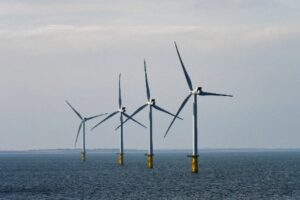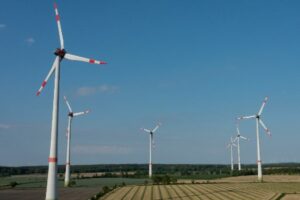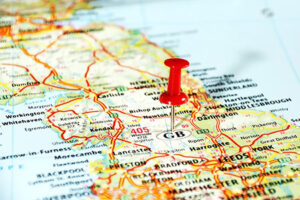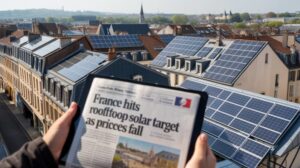How Wind Power Works? Unveiling the Mechanics of Wind Power
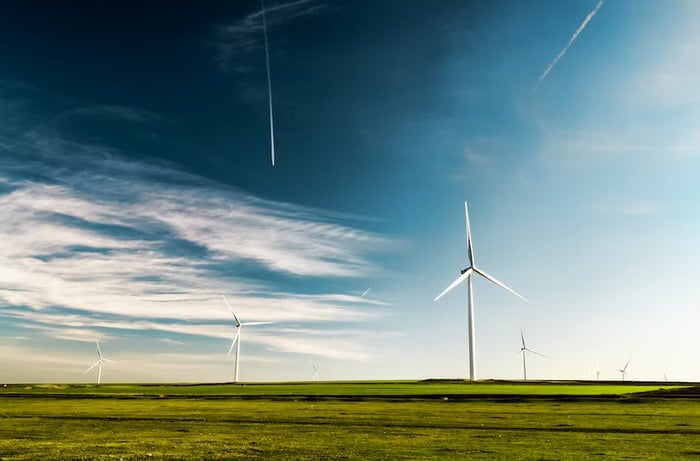
The world is undergoing an energy revolution, and wind power is at the forefront of this transformation. But how, exactly, does wind power work? What enables those colossal turbines to generate clean and renewable energy, reshaping our energy landscape and contributing to a sustainable future? Let’s embark on a journey to unravel the mechanics behind wind energy to understand how wind power works, and explore its potential as a key player in the quest for cleaner, greener energy.
1. The Essence of Wind Energy
At its core, wind energy is the conversion of kinetic energy from the movement of air (wind) into mechanical and then electrical energy. The primary tool for this conversion is the wind turbine.
2. Anatomy of a Wind Turbine
A wind turbine consists of several essential components:
Blades
These long, aerodynamic blades capture the wind’s energy. Modern wind turbines typically have three blades, but some variations may have two or more. The shape and size of the blades are carefully designed to maximize efficiency.
Rotor Hub
The blades are connected to the rotor hub, which is attached to the main shaft.
Main Shaft
The main shaft is the central axis of the wind turbine, and it connects the rotor hub to the gearbox.
Gearbox
The gearbox is a critical part of the turbine. It increases the rotational speed of the slower-moving blades to a level suitable for electricity generation.
Generator
The generator, often located within the nacelle, converts mechanical energy from the spinning shaft into electrical energy.
Nacelle
The nacelle is a housing that contains the gearbox, generator, and control systems. It sits atop the tower and can swivel to face the wind.
Tower
The tower supports the turbine and elevates it to capture stronger winds at higher altitudes. Tower heights can vary but typically range from 80 to 120 meters (262 to 394 feet) or more.
3. How It All Works?
The operation of a wind turbine consists of several steps:
Step 1: Wind Capture
As the wind blows, it encounters the turbine blades. The unique design of these blades allows them to capture the wind’s energy and convert it into rotational motion.
Step 2: Energy Transfer
The spinning blades transfer their energy to the rotor hub, which is connected to the main shaft. The main shaft, in turn, transmits this rotational motion to the gearbox.
Step 3: Speed Amplification
The gearbox’s primary function is to amplify the rotational speed. The initial rotation of the blades is relatively slow, but the generator requires a much higher speed to generate electricity efficiently. The gearbox serves as the intermediary, increasing the speed.

Wind farm in Eastern Europe, image source: Unsplash
Step 4: Electrical Generation
Once the rotational speed reaches the desired level, the generator transforms mechanical energy into electrical energy. This process utilizes the principle of electromagnetic induction, where the relative motion between magnets and coils generates an electrical current.
Step 5: Power Transmission
The electricity generated by the wind turbine is then transmitted through cables within the tower and, eventually, to the electrical grid. It may be necessary to condition the electricity to match the grid’s voltage and frequency.
4. Wind Power’s Advantages
Wind power offers a host of advantages, including:
Renewability
Wind is an abundant and perpetual resource, making wind power a sustainable and renewable energy source.
Clean and Green
Wind power produces no greenhouse gas emissions or air pollutants, contributing to cleaner air and a healthier planet.
Economic Benefits
The wind industry fosters job creation and economic growth, particularly in regions with significant wind resources.
Energy Security
Wind power diversifies the energy mix, reducing dependence on fossil fuels and enhancing energy security.
Reduced Environmental Impact
Wind turbines have a relatively small physical footprint and can be sited without significant habitat disruption.
5. Challenges and Considerations
While wind power is a promising energy source, it also faces challenges, including intermittency (the wind doesn’t always blow), visual and noise concerns, and the need for extensive infrastructure. Advances in energy storage, grid management, and turbine technology are helping to address these issues.
6. The Path Forward
As the world transitions to a more sustainable energy future, wind power’s role is poised to expand significantly. Its potential as a clean and renewable energy source, combined with ongoing technological advancements, positions it as a critical component of our collective effort to combat climate change and reduce our carbon footprint.
7. The Influence of Wind Speed
The power generated by a wind turbine is directly proportional to the cube of the wind speed. This means that even a modest increase in wind speed can lead to a significant boost in electricity production. Wind turbines are strategically placed in locations where consistent and strong winds prevail, such as coastal areas, open plains, and elevated regions.
8. Wind Energy Variability
One of the challenges of wind power is its inherent variability. Wind is not a constant resource, and its speed and direction can change frequently. To ensure a stable electricity supply, wind farms are often connected to the electrical grid, allowing for the integration of various energy sources and energy storage systems to compensate for fluctuations in wind power.
9. Impact on Wildlife
While wind power is celebrated for its environmental benefits, wind turbines can pose risks to wildlife, particularly birds and bats. Conservation efforts have led to the development of technologies and siting strategies to reduce the impact on local ecosystems. These include avian-friendly turbine designs and careful placement of wind farms.
10. Offshore Wind Farms
In addition to onshore wind farms, the development of offshore wind farms is gaining momentum. Offshore wind turbines are positioned in bodies of water, typically in shallow coastal areas. They benefit from stronger and more consistent winds, and they often face fewer land-use and visual concerns. As technology and experience in offshore wind continue to advance, these projects are becoming increasingly feasible and efficient.
11. Long-Term Sustainability
The sustainability of wind power depends on responsible practices in manufacturing, siting, and decommissioning of wind turbines. The industry is committed to addressing these concerns to ensure that wind power remains an environmentally responsible and sustainable energy source.

Offshore wind farm in Baltic Sea, image source:
12. Global Growth and the Energy Transition
The adoption of wind power is a global phenomenon, with countries around the world recognizing its potential as a clean and renewable energy source. As part of the broader energy transition, wind power is playing a pivotal role in reducing carbon emissions, combating climate change, and fostering a sustainable energy future.
Conclusion: The Winds of Change
Wind power is not just a source of clean and renewable energy; it’s a symbol of our commitment to a more sustainable future. Harnessing the power of the wind, wind turbines stand as sentinels of our ongoing transition to a cleaner, greener, and more responsible energy landscape.
As technology advances, wind energy’s capacity grows, and environmental concerns are addressed, wind power will continue to play a central role in the quest for a more sustainable and environmentally conscious world. The future of energy lies in the winds of change, and as they continue to gust and sway the blades of turbines, they usher in a new era of clean and renewable power generation.
